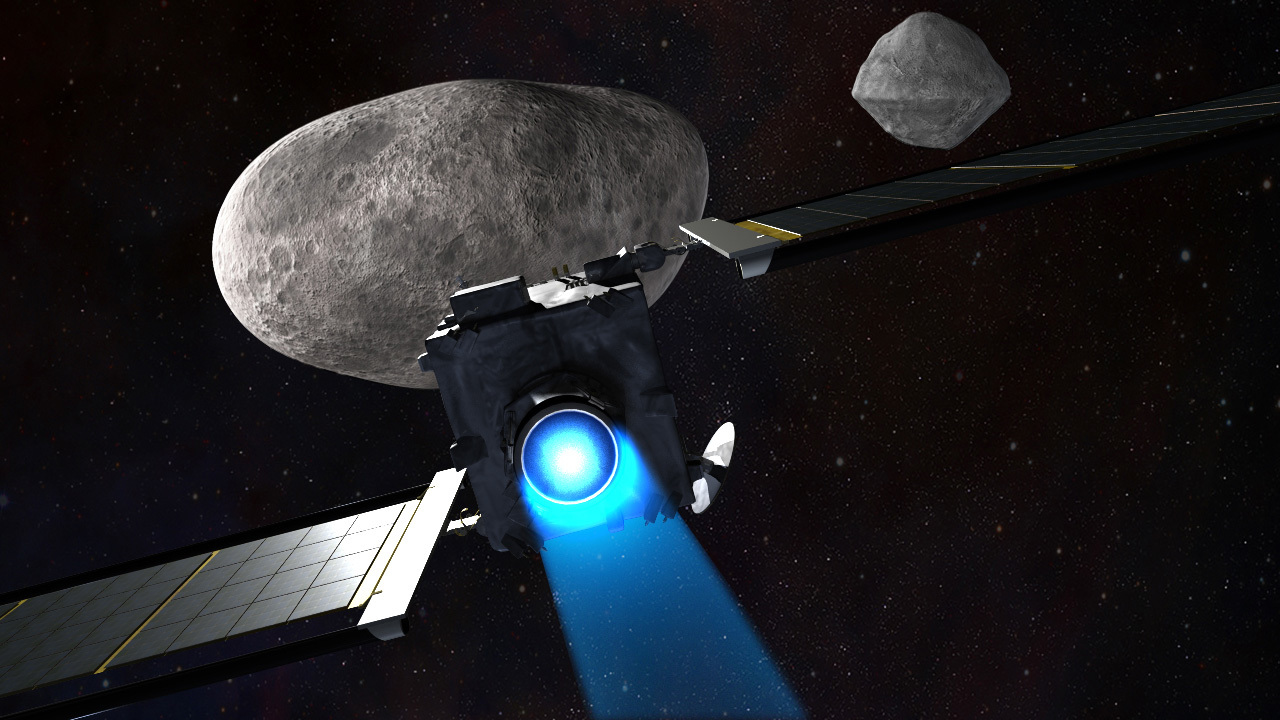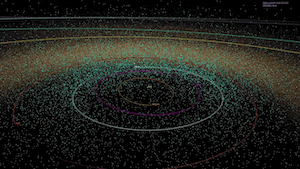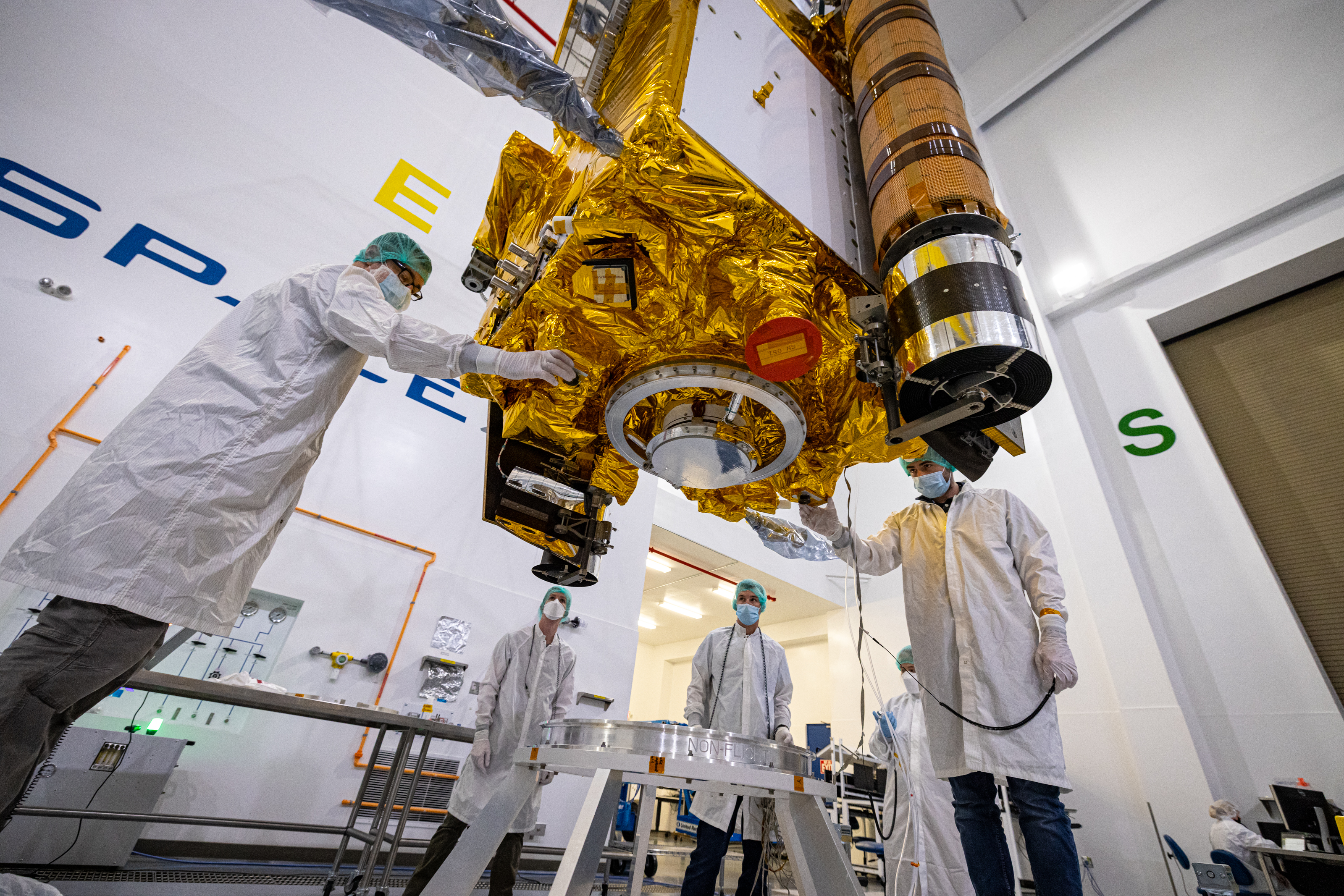If an asteroid really threatened the Earth, what would a planetary defense mission look like?
NASA's new DART mission could be a template to defend our planet.

Someday, tucked away gathering dust in a nondescript warehouse, there will perhaps be a spacecraft waiting to be called to the launch pad, even as its builders pray it never flies.
It wouldn't be a typical spacecraft, kitted out with as many high-tech instruments as engineers can cram aboard, and it wouldn't be designed to tease apart a single scientific mystery. Instead, it would be assigned a far more somber task: to deflect an asteroid on course to hit Earth.
Today, there is no such asteroid, although scientists are tracking more than 27,000 rocks rattling around Earth's neighborhood of space. But experts in the field they call planetary defense know that just such an object killed off most of the dinosaurs, and they're determined to see to it that humans don't meet the same fate. The solution? Nudge any threatening asteroid just enough to avoid the collision.
Related: How did you spend your week? NASA pretended to crash an asteroid into Earth.
Now, the first-ever planetary defense spacecraft is at Vandenberg Space Force Base in California, waiting for its first launch opportunity early on Nov. 24 (late Nov. 23 local time). That mission, NASA's Double Asteroid Redirection Test or DART, is doomed to spend less than a year in space and make a stunning exit by slamming into the moonlet of an asteroid called Didymos. If all goes well, it will give planetary defense specialists their first real-world data about deflecting space rocks.
"It's not a new problem: people have known this is something that is a potential hazard, and people have been wanting to take steps to prevent this in the future," Nancy Chabot, a planetary scientist at the Johns Hopkins University Applied Physics Laboratory in Maryland and the coordination lead for DART, told Space.com. "Probably this was a gleam in people's eyes for a long time."
There's more than one way to deflect an asteroid, but DART is testing the kinetic impactor technique — a fancy way of saying that if you slam an orbiting asteroid head-on with something massive enough at a fast enough speed, the asteroid's orbit changes. First, it slows down, but that means it falls toward the object it's orbiting. Through a nifty trick of physics, the closer orbit makes for a slightly faster orbit than the rock's original path.
Get the Space.com Newsletter
Breaking space news, the latest updates on rocket launches, skywatching events and more!
Target acquired
DART will crash all of its 1,210 pounds (550 kilograms) into an object called Dimorphos, which is a small moonlet orbiting its parent asteroid Didymos. "DART's target is really well chosen," Chabot said. She's speaking for the mission team; if you were Dimorphos, you might disagree.
Scientists believe that both rocks in the system are the most common flavor of near-Earth asteroid, stony or S-type. At 2,560 feet (780 meters), Didymos is about as wide as a particularly lofty skyscraper is tall; Dimorphos is more like the size of the Great Pyramid in Egypt, at about 530 feet (160 m) across.
That size is particularly tempting for planetary defense specialists, who class asteroids into three categories. The largest ones, more than 3,300 feet (1,000 m) wide, could cause the most damage, but they're also the easiest to find, so scientists are pretty confident they've seen most of them. None are a threat. The smallest asteroids aren't hefty enough to cause much damage; some don't even survive the trek through Earth's atmosphere.
The middle category, of rocks more than 460 feet (140 m) but less than 3,300 feet across — that's what worries planetary defense experts. These asteroids are harder to spot than the largest ones, but could still cause regional devastation if one hit Earth. Dimorphos matches that size perfectly.

The DART team also wanted to target a moonlet orbiting a larger asteroid instead of an asteroid orbiting the sun. That choice was in part for convenience and in part out of caution. For one, the DART leaders are confident that nudging this object isn't going to accidentally send anything hurtling toward Earth, worsening the very problem the team is trying to work toward solving.
And whereas a single asteroid orbits every few years perhaps, Dimorphos orbits Didymos once every 12 hours or so. The DART team expects the impact will shave perhaps 10 minutes or so off that rhythm — a difference that is much more noticeable against a 12-hour orbit and can be clocked more quickly.
DART's observations will be the first real-world data that would-be planetary defenders can feed into the models that tell them just how big a spacecraft going just how fast might be enough to ward off an asteroid.
That's the sort of work that Brent Barbee, an aerospace engineer at NASA's Goddard Space Flight Center in Maryland, specializes in. Barbee designs hypothetical spacecraft missions, in particular for the practice scenarios the planetary defense community runs through at the field's main conference, held every two years.
"The results from the DART mission are going to be informing our hypothetical work on planetary defense going forward in numerous ways," Barbee said. "It's going to be affecting the way we think about planetary defense mission design for many years to come, so the importance of the mission in that regard really can't be understated."
Everything depends on timing
Scientists in the planetary defense community are quick to note that no one can deflect a threat that isn't detected, and the more warning time Earthlings have, the better the situation will turn out for us.
Warning time is vital for an approach like DART's kinetic impactor because the change expected in an asteroid's orbit is fairly small, so the asteroid needs to make a few loops of the sun to build up a difference from its original position's impact with Earth. "When you've got a couple decades' worth of warning time, the kinetic impactor can be quite sufficient to get the job done," Barbee said.
With enough warning, even more possibilities open up, Chabot noted — like sending a spacecraft to scout out the threat and hone the deflection mission.
"When you have the warning time, one of the first things that you do is you go get a better look at what this thing looks like so you know what you're dealing with," she said. "The first thing that you send to this asteroid might not be the one that you're looking to deflect it with."
Scientists can only learn so much about any given space rock from Earth: its orbit, a vague size estimate, perhaps a fuzzy idea of its shape and composition. All of those factors affect the design of an optimal planetary defense mission.
"That would be useful information that we don't have very much for DART," Chabot said. "That makes it actually maybe a little more challenging than if you had a longer warning time."
The human factor
In a real planetary defense scenario, a particularly crucial use of warning time would have nothing to do with asteroids and would instead focus on humans.
Whether or not there's still time to try to stave off the space rock, international conversations will be vital. Some countries may be hit, some countries may be able to act to stop the impact, some countries may see collateral effects, and all countries ought to be involved in the planet's response, planetary defense experts emphasize.
But unlike a situation like a pandemic or climate change, there are no formal, specialized international organizations to tackle such an unlikely catastrophe, Alissa Haddaji, a faculty member teaching space law, policy and ethics at Harvard College in Massachusetts, told Space.com. Instead, the U.N. Security Council would be in charge; that's one reason why planetary defense experts focus so much on communication with other communities.
Legally, planetary defense is particularly tricky because one potential deflection technique relies on nuclear explosives, yet nuclear weapons are not permitted in space. Laying the groundwork for conversations that could work around such rules and international nuclear fears is a key focus for Haddaji.
"The joke that I make with my colleagues is that my planetary defense research has a 99.99999% of not being useful ever — or 0.00001% chance of being extremely helpful one day," Haddaji said.
As the field of planetary defense has developed, she noted, it has become more interdisciplinary, with ties to not just science and spacecraft engineering, but also international law and disaster response personnel. For one example, she leads a group of lawyers that advises planetary defense scientists on legal implications and complications of the work.
Even when a threat is hypothetical, communication is vital, she said, because if people are aware of the idea of an asteroid impact, there's a lower chance that news of an incoming object would terrify them into paralysis. But planetary defense experts are also wary of sounding too loud an alarm.
"You don't want to go into this scaring the population, and especially not using scare tactics to raise funding to get money for planetary defense, that's not something anyone of us would ever agree to do," Haddaji said.
Time to launch
Say all those conversations come to the conclusion that some coalition of humans will attempt to deflect the threatening asteroid. It's time to design a mission to save the world.
The kinetic impactor approach is only one technique that planetary defense specialists consider for moving an asteroid's path. Other options may be to use lasers, a companion spacecraft's gravity or a nuclear explosion. Which option makes the most sense when needed will depend on the warning time Earth has and the size of the asteroid.
Sometimes, a deflection will even require more than one mission, increasing the difficulty of the project. Any one launch will require two pieces: rocket and spacecraft.
Whether there really would be a spacecraft stashed away in case of a foreseen asteroid apocalypse is one of the many choices that planetary defense experts want the planet to consider.
"Would we still do a build-on-demand approach, or would we prefer to maybe do a modular build?" Barbee said. "Or would we have an entire spacecraft basically built and put in a warehouse or something? That's also a question mark."

Ditto for finding the thrust to launch. "One of the things that would be really helpful would be to take a look at the processes involved in getting rockets ready for launch because typically that's not done in a hasty fashion," Barbee said. "Let's say you had less time: under current procedures it would be quite a scramble to get a rocket ready for launch in time."
And of course, the logistical problems multiply if a deflection were to require a series of launches. So does the risk of something going wrong — although that's a possibility that would-be planetary defenders would always need to evaluate.
A host of nightmare scenarios can unfold. Take, for example, a partial deflection, one that moves the asteroid but not enough to clear Earth. "It's still heading toward the Earth, but now the impact point is somewhere other than where it was before," Barbee said. "Now we've artificially created a different version of the disaster, different from what the natural version was going to be."
Or if a mass estimate is off, or the asteroid doesn't respond as predicted. "It's plausible that you could inadvertently break off a chunk of the asteroid when you hit it rather than just deflecting it as a whole unbroken object," Barbee said. Those fragments would then pose their own threats.
So that spacecraft in a warehouse had better have a companion. "You wouldn't just send one," Chabot said. "You maybe would want to send one and then send another one that would arrive like a few weeks later, see how the first one did and see if you needed to push it a little bit more or push it a little bit less."
The $330 million DART mission, in fact, does have a successor that plans to visit the scene. The European Space Agency will launch a spacecraft named Hera in 2024, after the dust has settled, to allow scientists to understand in even more detail the factors that a real planetary defense mission may need to consider.
"This isn't the answer of exactly what you would do," Chabot said. "DART is the start; this is the first step."
Email Meghan Bartels at mbartels@space.com or follow her on Twitter @meghanbartels. Follow us on Twitter @Spacedotcom and on Facebook.
Join our Space Forums to keep talking space on the latest missions, night sky and more! And if you have a news tip, correction or comment, let us know at: community@space.com.

Meghan is a senior writer at Space.com and has more than five years' experience as a science journalist based in New York City. She joined Space.com in July 2018, with previous writing published in outlets including Newsweek and Audubon. Meghan earned an MA in science journalism from New York University and a BA in classics from Georgetown University, and in her free time she enjoys reading and visiting museums. Follow her on Twitter at @meghanbartels.









